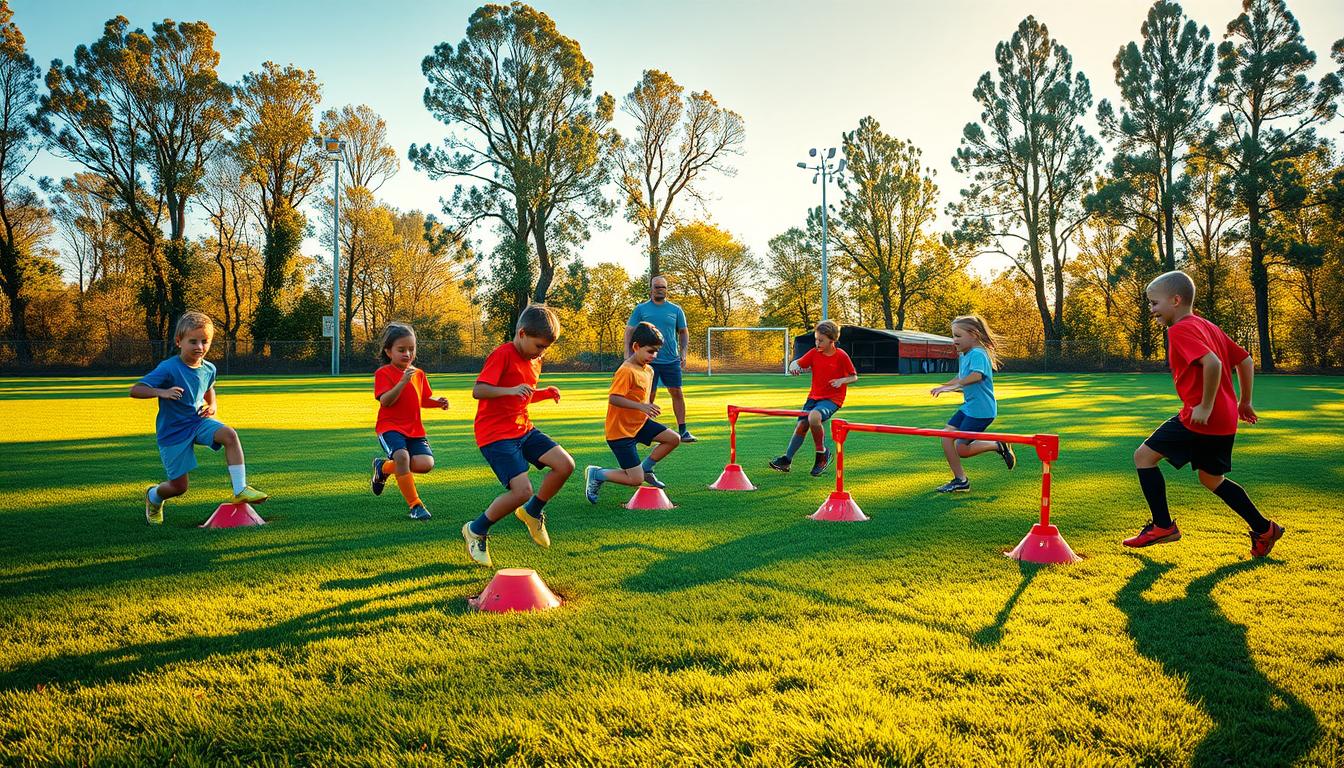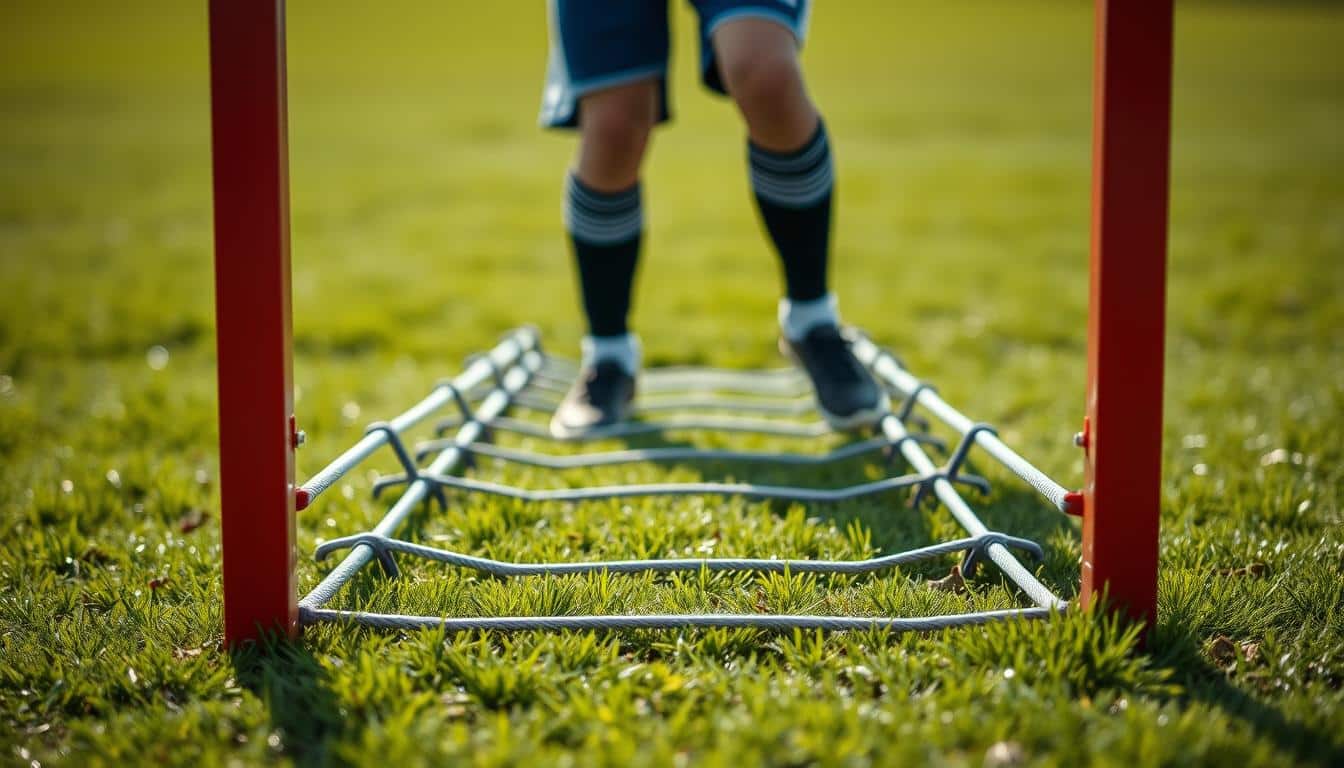Agility Drills for Kids Soccer

Have you ever wondered how a few short, focused exercises can turn a hesitant player into a confident, quick mover on the field?
I want to help you use simple gear and clear steps so you and your players see real gains fast. I teach technique first. Then we add speed. That order protects the body and makes each skill stick.
Short, fun sessions build coordination, balance, cutting, and safer stops. A couple of cones, a ladder, and a 5×5 box set up in minutes. You can run meaningful training at home or practice without stress.
In this guide I show step-by-step patterns, cue words like shuffle and cut, and how many reps fit a short block of time. You’ll learn four-cone patterns, shuttles, mirror boxes, ladder moves, and a zig-zag dribble that link to game play.
I keep energy positive so each player learns one small skill per session. By the end, you will see better body control and faster, cleaner movement that lowers injury risk.
Key Takeaways
- Start with clean technique, then add speed.
- Use minimal gear: cones, ladder, and a small box.
- Short sessions boost coordination and cutting skills.
- Plan reps and rest to fit your practice time.
- Keep cues simple to help players focus and improve.
Why agility matters for youth players today
Quick feet and sharp movement make a player harder to beat in tight moments. Good movement lets a player accelerate, change direction, and react faster in real play.
Agility builds faster reaction time and cleaner footwork. That means a player reads the play and moves first, not after.
It also improves body control. Players learn to land softly and push off with power from a stable base. That protects knees and ankles during sharp cuts.
Key benefits: quick feet, reaction time, and body control
- Win loose balls and avoid tackles by changing direction while keeping control.
- Quick feet and clean footwork boost reaction time to visual cues.
- Short cone and box work build coordination and control with low impact.
How agility reduces injury risk in growing athletes
Agility training strengthens muscles, joints, and ligaments. This lowers sprain risk and supports safe landings.
Players must keep a low chest and bend at hips and knees when planting. That form cuts strain and keeps balance.
Two to three short sessions per week give steady gains in movement skills and confidence without overload. Small wins build belief and make practice fun and focused.
Safety, warm-up, and simple setup with cones, ladders, and a ball
A safe setup and a clear warm-up make every minute of training count. I start by checking the ground. Remove holes, wet spots, and hazards so players have steady footing.
Set a 5×5 yard box for mirror work. Place cone lines with 3–5 yards between each cone for shuttle runs. Lay an agility ladder nearby and keep one ball per player if you add dribbling later.
Warm-up flow: begin with an easy jog. Add dynamic moves like high knees, leg swings, and hip openers.
Finish warm-up with two to three short accelerations. Keep the first reps slow and clean. Increase speed only when feet and the body look stable.
- Keep knees bent, hips back, and arms pumping to maintain control.
- Tell players to face forward in mirror box work.
- On backpedals keep a slight forward lean to stay balanced.
- Set clear work and rest time and keep water nearby.
End the warm-up with one simple pattern at a pace that feels fast possible without losing form. Coaches stress technique first, then speed. That builds confidence and safer movement.
Soccer agility drills for kids
Small, focused patterns teach quickness and safe cuts. Below are four clear exercises you can run in short time. Each set keeps form first, then speed.
Four-cone pattern: sprint, shuffle, backpedal combo
- Set three cones in a line, five yards apart. Place a fourth cone five yards off the middle.
- Sprint to the middle cone. Shuffle to the side cone. Sprint across. Shuffle back.
- Backpedal to the start. Repeat 2–4 runs. Focus on knees bent and quick feet.
Mirror boxes: lead and follow
- Make two 5×5 yard boxes side by side. One leader, one mirror.
- Leader moves to cone corners. Mirror matches steps while facing forward.
- Work 30–90 seconds, then swap. This builds reaction time and body control.
Red light, green light
- Place two cone lines 30–40 yards apart. Sprint on “green,” stop on “red.”
- Add colors or a ball later. Start simple to lock in hard stops.
Teammate chase drill
- Use a 20×20 yard grid. One chaser tries to close a two-yard gap.
- The lead player changes direction and pace to force clean cuts.
- Switch roles fast so every player gets reps.
Keep work bouts short and rotate often. If you want more cone game ideas, try this cone session guide.
Agility ladder basics: fast feet and clean patterns
Start your ladder session with simple steps and clear cues to build confident footwork.
I use one or two ladders and small groups so each player gets frequent turns. Begin slow. Teach arm drive and light steps before adding speed.
Core progressions:
- One foot in each box — steady arms, quiet chest, place the foot under the hips.
- Two feet in each box — build rhythm, then turn sideways for lateral steps.
- Hopscotch and icky shuffle — add bounce and an in‑in‑out pattern for better coordination.

Coaching cues and sets
Keep cues short: “light feet,” “hips under,” “arms drive.” Run 2–4 times per pattern with a walk-back rest. Add a 10–15 yard sprint after the ladder to link quick feet to open-ground speed.
| Pattern | Main Focus | Reps |
|---|---|---|
| One foot each box | Control, timing | 2–4 runs |
| Two feet each box (linear & lateral) | Rhythm, hip movement | 2–4 runs |
| Hopscotch / Icky shuffle | Bounce, coordination | 2–4 runs |
Cone shuttles and weave runs for quick changes of direction
Set up a simple line and watch players learn quick stops, tight turns, and faster starts.
Sprint‑Backpedal‑Turn drill (layout): place a line of 3–5 cones, 5–7 yards apart. Sprint to cone 3, backpedal to cone 2, sprint to cone 4, backpedal to cone 3, then sprint past cone 5. Repeat 2–4 times. Keep a slight forward lean on the backpedal and short, controlled steps before each turn.
Sprint‑backpedal cues
- Hips low, eyes up, quick plant under the body.
- Use even foot plants to protect the ground contact.
- Stop the set if speed harms form; quality over time.
Shuttle take‑off and box/T progressions
Set two cones 20 yards apart and a third cone 10 yards beyond. Jog at 75% to cone two, then sprint full speed to the third. Repeat 6–8 times with walk‑back recovery.
Weaving shuttle with short, sharp cuts
Place ten cones five yards apart and weave in and out as fast as possible. Focus on short cuts and fast re‑acceleration. Scale to a box or T‑drill when space is tight so each player masters one clear pattern before adding speed.
| Drill | Layout | Reps |
|---|---|---|
| Sprint‑Backpedal‑Turn | Line of 3–5 cones (5–7 yds) | 2–4 |
| Shuttle Take‑Off | 2 cones (20 yds) + 1 (10 yds) | 6–8 |
| Weaving Shuttle | 10 cones, 5 yds apart | Walk back recovery |
Add the ball: dribbling patterns that build control and speed
Add the ball to short patterns so players learn to move and control at pace.
Set up: place cones in a zig-zag 2–3 yards apart. Start with 6–10 cones so each run feels like progress.
Zig-zag cone dribble with low center and close touches
Keep a low center. Bend the knees. Take short steps and use quick, controlled cuts around each cone.
- I add a soccer ball and cue light, close touches so the ball stays within one step.
- I teach inside-edge and outside-edge touches with the lead foot. Plant with the other foot to hold balance.
- I tell players to keep eyes up between cones to scan and pick the next direction calmly.
- I start slow, then build speed while keeping the ball under tight control.
- I swap dominant and non-dominant feet each run so both sides improve.
Finish: end with a short race. Two players run the same path and keep control to the end. That adds game pressure and teaches calm speed.
Age and skill progressions in the United States
I design short, clear progressions so each age group learns the right movements at the right time.
U5–U8: play first, teach basic steps
Make sessions playful. Use tag, small obstacle runs, and simple ladders. These games grow coordination without pressure.
Keep sets short. Give plenty of rest and clear wins like “touch each cone.” Confidence and basic skill come fast this way.
U9–U12: add structure and reaction work
Introduce cone shuttles, mirror boxes, and partner shadow work. These build ability change direction and simple reactions.
I use ladders and short relays two to three times per week so training fits school and family time.
U13–U19: raise intensity and match positions
Increase shuttle intensity and add weave runs or hill resistance. Tie patterns to roles—mirror and T drills for defenders, zig-zag runs for wingers and attacking soccer players.
Track time on key drills so older players see progress and learn how rest, sleep, and food help training.
| Age group | Main focus | Session time |
|---|---|---|
| U5–U8 | Fun movement, coordination | 15–25 min |
| U9–U12 | Structured cones, reactions | 20–35 min |
| U13–U19 | Higher intensity, position work | 30–45 min |
Scale every set to the player’s body and skill. Keep form as the top priority. Two to three short sessions per week build speed, coordination, and control while avoiding overtraining.
Conclusion
A few simple blocks of focused time will move a player forward fast.
Pick two agility drills and run each in a 10-minute block this week. Follow with one short sprint set. Keep ladder work to 8–12 minutes, shuttles at 2–4 reps, and mirror rounds for 30–90 seconds.
Teach clean footwork first. Add speed only when a player stays balanced through each cone and box. Use 5×5 yard boxes and cones 3–7 yards apart.
Use a cue like “left” or “red light” to train reaction time every session. Watch posture on the backpedal, plant under the center, and push to leave the ground clean on each change.
I’m here to help you keep it simple, keep it fun, and help players grow step by step with safe ladder drills and four cones work.
